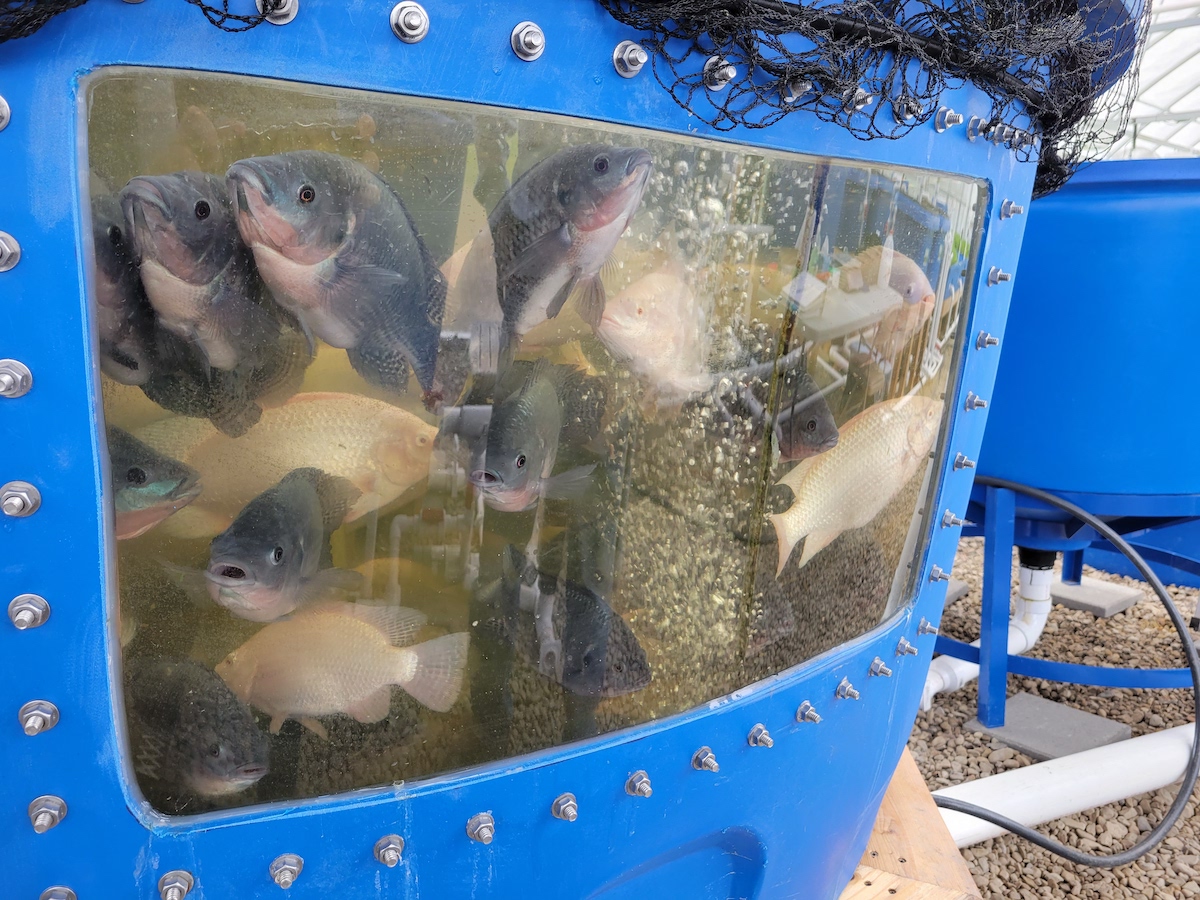
LISBON, Ohio — Doug Hiscox isn’t a salesman, but he’s found that aquaponics has a way of opening up conversations when he stops at local markets and restaurants to pick up new business.
People are naturally fascinated by the agricultural system that combines aquaculture, or raising fish, and hydroponics, growing plants in water instead of soil.
“We grow three things: fish, bacteria and lettuce,” Hiscox said.
Together with his wife, Linda, Hiscox started Cave Creek Aquaponics. It’s a second career for him. He retired from his job as a school administrator three years ago. They sold their first cutting of lettuce about a month ago.
Hiscox sees a lot of potential in aquaponics. It conserves resources. There’s no soil required and most of the water used is recycled back through the system. It doesn’t require much land to operate. It doesn’t use chemical fertilizers or pesticides. You’re not reliant on good weather and other uncontrollable factors for a good crop.

“This is another way of farming that has a lot of potential,” he said.
Getting started
Hiscox had no experience in growing vegetables before getting into aquaponics. He was an educator and administrator, who did some farming on the side with his family. They raised beef cattle and some crops, but it was a hobby more than anything.
He got interested in aquaponics about 10 years ago. Hiscox said he liked the science behind it. That appealed to his science teacher background. It also helped ease his mind over environmental issues that bothered him about conventional farming — the immense land use and the reliance on fertilizer and pesticides.
Doug and Linda Hiscox jumped into the new adventure less than two years ago. They cleared the ground in November 2021 on a half acre property they own north of Lisbon and started building the greenhouse in April 2022. The greenhouse is 100 feet by 130 feet.
The system was turned on for the first time early this year. Taking care of fish was a whole new experience for Hiscox.
“I’ve taken care of animals before, but with fish, it was a different ball game,” he said. “You don’t know what you don’t know, but you figure it out.”

How it works
The fish arrive in the mail as fingerlings from New Mexico. They stay in the smaller nursery tanks until they’re about 10 weeks old. At that point, they are moved into the main aquaponics system into 500 gallon tanks.
The fish are ready for harvest at 26-weeks-old. They’ll weigh between 2-2.5 pounds. Hiscox said he hasn’t yet harvested fish but he’s working on building those connections to sell live fish or whole fish on ice to Asian markets. The first batch of fish should be ready in June.
Lettuce is planted every day and harvested every day. That’s 200 seeds planted every day, and about 200 pounds of lettuce harvested each day.
The lettuce plants grow for 14 days in a large combined mat before being separated and moved into individual spots to grow another 14 days. Then, it’s time for the lettuce to go into the water bed in the full system. Plants are placed in foam boards that float in about 18 inches of water. It’ll be another couple weeks until the lettuce is ready to be harvested.
The same water flows through the entire system and is continuously recycled. Water from the fish tanks goes through a nitrification process that uses bacteria to create nitrates to fertilize the plants in the water beds. Fish give off ammonia from their gills and in their excrement.
Solid waste that is separated out of the fish tank water is filtered and also gets turned into nitrates.
The plants like about 13 hours of light a day, so there are lights on timers that turn on when the daylight is short in the winter months. The water temperature stays at about 75 degrees Fahrenheit. The air temperature is about 65 degrees. It’s a nice place to be in the dead of winter or on a rainy day, Hiscox said.

Benefits
Hiscox said the aquaponics systems are resilient. It’s relatively self-contained. A fertilizer shortage or a price spike, like what happened last year, wouldn’t impact his crop operation.
There’s little waste in an aquaponics system. There is some evaporative loss in the system. Hiscox said he replaces about 100 gallons of water a week. But that’s a small amount compared with how much water is flowing through the system at any given time.
There was the initial investment to put up all the infrastructure. The aquaponics system, a small commercial aquaponics system, came from a Wisconsin based company called Nelson and Pade and cost $85,000. Hiscox said it cost him about $300,000 total to get started.
He estimated he’ll have a return on his investment in four years. Hiscox feels the costs are comparable to getting started in other types of commercial agricultural businesses.
You can buy Cave Creek Aquaponics lettuce in local markets, like White House Fruit Farm, in Canfield or Catalpa Grove Farm, in Columbiana. He also sells to restaurants. They hope to find more markets for their year-round, locally raised produce as they go.
(Reporter Rachel Wagoner can be reached at 724-201-1544 or rachel@farmanddairy.com.)









